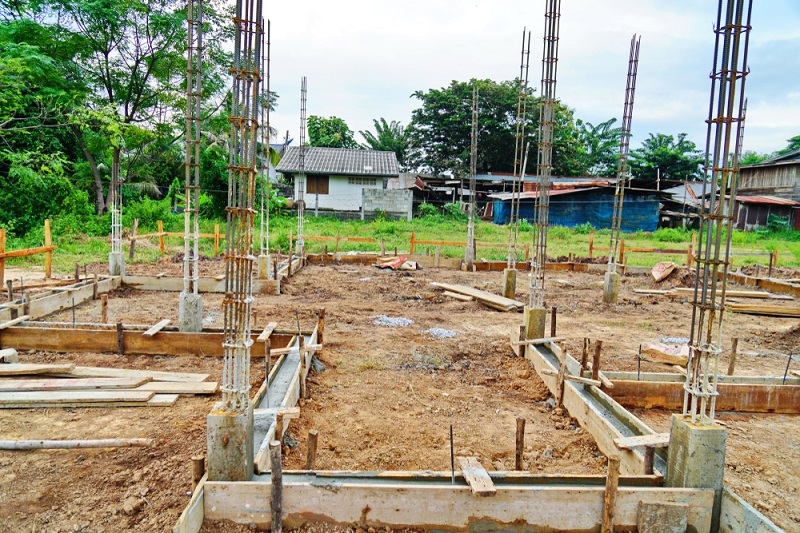 The foundation plan shows how the foundation runs. This is the pillar of every building. Knowing the foundation and its characteristics is essential, whether a family house is to be built or a garage is to be set up.
The foundation plan shows how the foundation runs. This is the pillar of every building. Knowing the foundation and its characteristics is essential, whether a family house is to be built or a garage is to be set up.
Create a Foundation Plan: Own Contribution or Not?
Some ambitious builders are pretty confident in preparing the foundation plan. But these builders should be saying that it is always better to trust a professional when building a house. The architect carries out the foundation planning throughout the home.
Consequently, it is not even the architect but the structural engineer who sets the exact planning. He has to calculate at which point in the house loads will lie, what has to be intercepted, and how great the load for the concrete foundation will be.
Since a structural engineer must be called in any way during the house planning, the foundation planning does not even represent an expensive additional service. A fear that many builders carry in themselves and therefore want to do as much as possible themselves. But just the foundation must fit; it represents the feet of the house.
Therefore, no builder should concrete the floor slab on their own, especially since all their own services can lead to problems or even to the exclusion of the warranty by the trades.
The reinforcement specified by the structural engineer must be adhered to during construction. The following are included in this plan:
- How is the foundation formed?
- Where does it take so much steel to get into the bottom plate?
- How should the concrete mix be composed?
- Which connections have to be considered?
- What is the exact course of the foundation?
Foundation Plan: Also Important For Outbuildings
Not only should the new family home be on safe feet, but the garage or other outbuildings are usually built on a foundation. The reinforcement also ensures the walls are safe and the entire load is secured. Vertical and horizontal loads are distributed. It is also essential to catch any settlements with the foundation.
If you move into a newly built building, you may notice in part how the floor slab lowers. Above all, the acrylic edges on tile transitions between floor and wall tear often cause significant gaps in between. Also, on vertical edges, it can be observed that, for example, a wallpaper warps. These are signs of a sinking bottom plate, which usually does not sink evenly throughout the house.
Therefore, the dimensioning of the reinforcement in the foundation plan, which is based on the calculated bearing capacity of the soil, is essential. This is the only way to ensure that the load-bearing walls are such and do not give way unanticipated.
Different Foundations Are Common:
Strip foundation
This is mainly used under load-bearing walls. The strip foundation is composed of excavated foundation strips and a formwork set up to the lower edge of the bottom plate. Conventional and special foundation formworks are used.
Important: If it concerns a boundary development, as it often occurs, for example, in outbuildings such as the garage or the subsequent extension as an extension of the house, the strip foundation may not affect the adjacent property. For example, some angular foundations still bring the building to safe ground.
Foundation
Foundation slabs are also called surface foundations and are easier to handle because no formwork or excavation work is required. The floor panels are much thicker here and must be executed with a reinforcement. Overall, foundation plates are often cheaper than strip foundations and distribute the loads better than others. This is especially true for problematic soil conditions such as loose sand or a sand-clay mixture that reacts differently to wet and dry.
Single Foundations
For single foundations, no formwork anchors are installed in the lower area; this would complicate a later expansion. Instead, belt tensioners are embedded in the concrete, and the bracing in the upper area is carried out using the foundation formwork.
The foundation plan shows the exact nature and course of the foundation. It is, therefore, also an important document if, for example, a cellar should be installed later, for the construction of which the data on the foundation is important.
Loose sand and sand-clay mixtures are considered problematic soil conditions. Here, the so-called foundation or surface plates help.
Foundation Plan for Garden Shed and Garage: Specifications From The Manufacturer
Property owners are confronted with a foundation plan not only during the construction of the dwelling house. Even when it comes to the construction of outbuildings, a foundation plan can be significant. They are supplied with the purchase of prefabricated houses, which here are not real residential houses but rather garden sheds and garages.
The foundation plan specifies the dimensions of the necessary foundation and clearly shows where the base plate has to be applied. Based on the illustrations, the foundation is excavated, best done with a mini excavator.
The foundation plan shows many different trenches. They wind along the perimeter walls and show where load-bearing walls will be found. These trenches are dug after preparing the construction site for the floor slab.
Important: The walls of the trenches must be really solid; otherwise, there is a danger of collapse. Boards may be useful for making these trenches more stable. The trenches will later be filled with concrete, thus forming the basis for the concrete foundation.
The upper edges are later smoothed out as long as the concrete is still soft and malleable. After a few days, the bottom plate can be created, which is also done with concrete.
That’s Why The Foundation Plan is Important
Many property owners who only want to build a garage or build a house without a basement ask themselves if it is essential to have a foundation plan drawn. After all, it costs additional money, and in a smaller and thus less complicated construction, a simple concrete foundation without a precise plan is enough. Or not?
Every professional will answer this question with a clear ” No “because the foundation plan is indispensable for all major construction projects. A foundation plan is unnecessary when constructing a small equipment shed or a doghouse. Still, for all buildings or parts of buildings to be committed, a solid foundation with a good foundation plan is indispensable.
As a rule of thumb, the floor space of the building may not exceed five square meters, so no foundation plan is necessary. Loads heavy weights on the bottom plate and creates a massive structure; the plan is essential.
It records all relevant data, shows which reinforcement has to be in which position, and shows what quality of concrete is needed to give the whole building the right footing. Also, the strength of the bottom plate is called here.
In the case of a strip foundation, the correct positions of the strips are mentioned in the foundation plan so that these can be retrieved later.
Important: The foundation plan must also be implemented during construction. Building a base plate “roughly ” is not enough, and I hope this will have no consequences.
However, a foundation plan is of course not available free of charge, the structural engineer usually calculates its performance extensively. Nevertheless, this is a good investment as it provides more planning security and the required high-quality construction.
However, the total cost of the floor slab and the foundation plan can vary widely and depend, among other things, on the area in which the building is to be erected.


